Heat, Humidity & Mushrooms
Hot and humid weather is good for at least one thing: mushrooms. In the age of air conditioning some might lose touch with goings on during the dog days of summer, but for those of us who rely on open windows and thundershowers for cool air it's easy to recognize when mushroom hunting season in Connecticut has arrived.
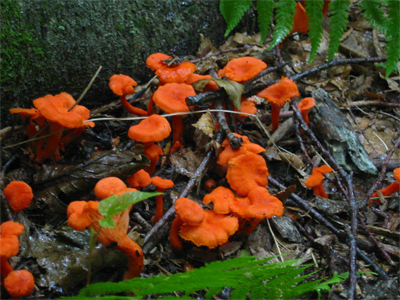
After several nights of sticking to the sheets the boys and I looked for a place to hunt mushrooms. We decided to walk the Weir Pond Trail at the Weir Farm National Historic Site in Ridgefield and Wilton (below). The trail rewarded us with a fungi bonanza, the nearby woods strewn with spectacular mushrooms such as Red Chanterelle (above) and representatives of many mushroom families.
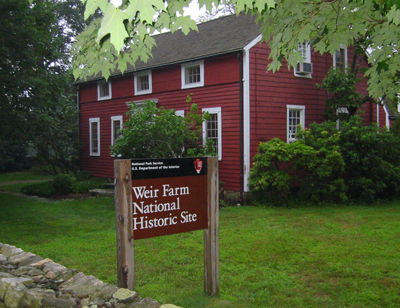
Armed with a dog-eared copy of "Common Mushrooms of New England", a wonderful guide and key to local fungi written by John C. Cooke and published by and available through the Connecticut College Arboretum, we did our best to try and sort out those that we might.
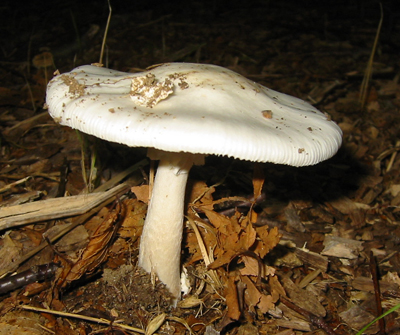
On our way in, at the margin where what were open farm fields when 19th century American painter J. Alden Weir lived here have yielded to deciduous forest, we found what seemed to be a Meadow Mushroom (Agaricus campestris), that grows in pastures (above).
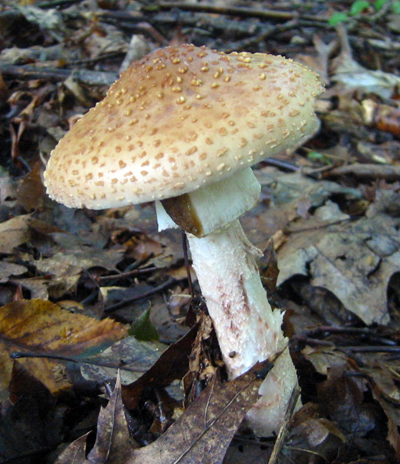
Among nearby trees were other mushrooms, such as the one pictured above, that seemed from the scale-like patches on its cap to be an Amanita, perhaps Amanita pantherina, commonly called the "Panther" amanita, or Amanita virosa, with the ominous sounding common name of "Death Angel".
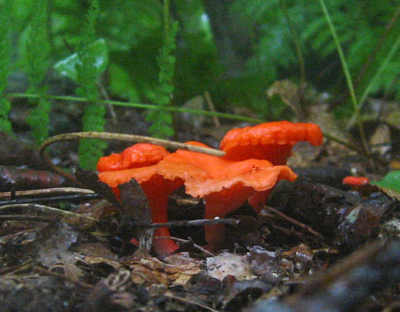
Even to our amateur eyes it was easy to pick out the many clusters of Red Chanterelles (Cantharellus cinnabarinus) (above) we found growing on the forest floor around the trunks of trees further down the trail. Bright orange, they stood out among the green ferns and grasses from at least ten feet away.

Perhaps most abundant in the forest were white and tan forms of milk caps (Lactarius piperatus) (above) that show funnel shaped caps that are depressed in the middle and have long gills underneath (below). The more of them we found, the more it began to rain, at time causing the lens of our trust Canon ELPH camera to fog over.
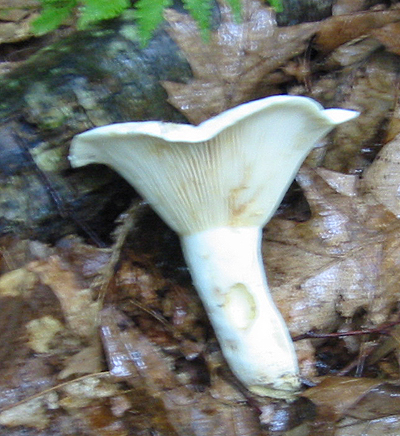
We found mushrooms similar in form to the milk caps, but showing different colorations, in areas around the forest floor. There were many Red Russula (Russula emetica) (below) scattered widely about along with groups of Green Russula (Russula virescens) off to one side of the trail where it approached Weir Pond (second photo below).
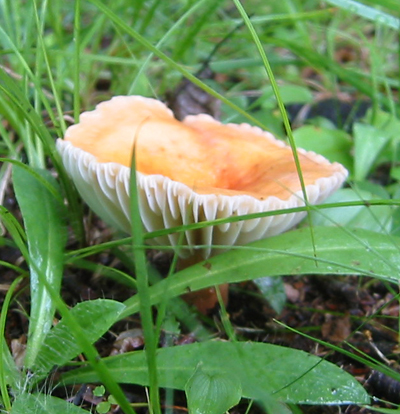

Along with the "gilled mushrooms" we found two varieties of "pored-fleshy mushrooms." These are distinguished by the pored surface they have beneath their caps rather than gills.
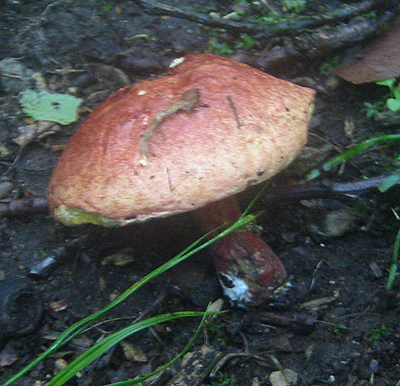
The first of these we found was a sort of two-colored bolete, with a red cap and stem (above), but a distinctly yellow pore surface (below).
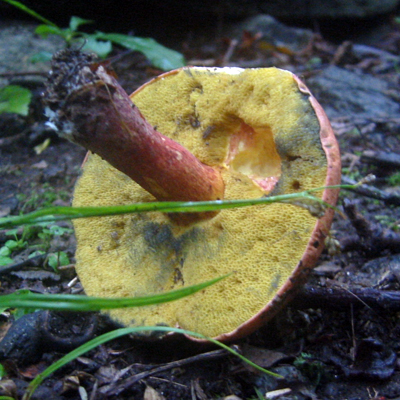
Another tan-colored pored mushroom found nearby looked to us to be Bitter Bolete (Tylopilus felleus) (below).
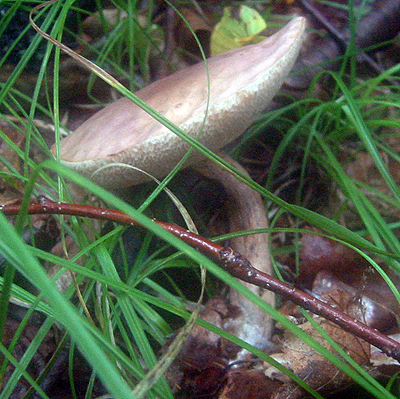
Also in the area where the trail approached the pond, where grasses patches exploited areas not yet fully filled by trees, we found coral mushrooms, named for the way they resemble marine corals, of the genus Clavaria (below).

Many downed tree trunks decomposing on the forest floor provided ideal conditions for bracket fungi.
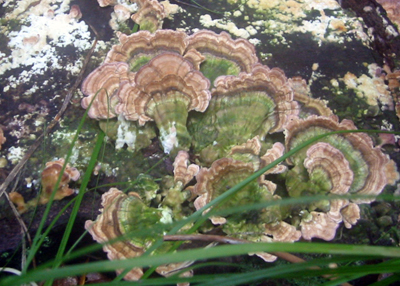
We found varieties of polypores that looked to us like False Turkey-tail (Stereum ostrea) (above),
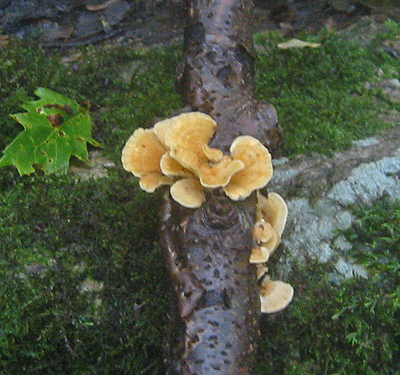
and Chicken-of-the-Woods (Polyporus sulphureus) (above).
Of course, there were two mushrooms that we couldn't even guess at. One is common, and probably familiar to most, but had us perplexed (below). Yellow mycena, perhaps?
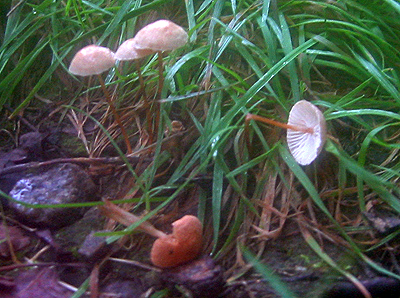
The other was a remarkable violet color, small and relatively squat, and apparenly just emerging (below).
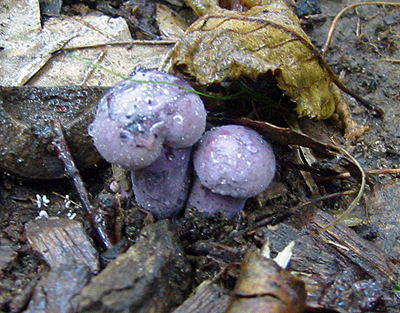
Toward the end of the hunt, after a heavy summer rain had come and gone and cooled things down a bit, we were rewarded with two unexpected finds. The first was to the right of the trail on our way back from the pond, we found several specimens of a plant known as Indian Pipe (Monotropa uniflora) just emerging (below). A ghostly white plant known for its lack of clorophyl, it could easily be mistaken for some kind of fungi.
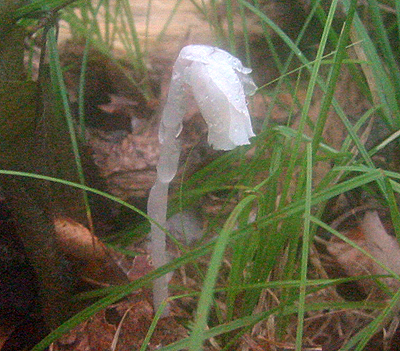
In searching for more we also encountered several apparently newly metamorphosed Spring Peeper frogs (below) barely one-quarter of inch long. They were so small they almost seemed like some sort of jumping flea, but were already such accomplished hoppers they could launch their tiny bodies twelve inches or more in a single bound.
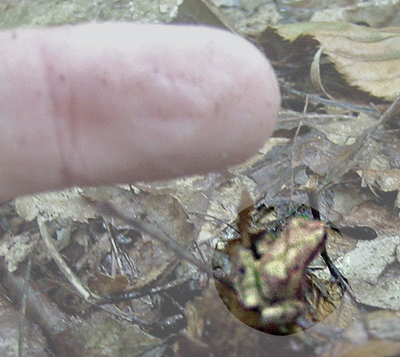
A truly remarkable trip we might have missed out on had we been spending our summer in the alternate reality that comes with cool, dry, conditioned air being blown into tightly insulated spaces.
7 Comments:
Nice pictures. Can you dis-claim any liability but mention which ones are considered edible? I see all these same mushrooms in Mass.
This comment has been removed by a blog administrator.
Hi,
My wife and I are curious to see if you have identified the purple mushrooms in your blog.We have found and photographed several previously unseen (by us)varieties of plants and fungi (especially the purple ones) in our area. If you would like to see the pictures we have for ID purposes please let me know.
Thank You,
-George
Nice.I've started a mushroom club, and your information was very useful.
I love these pictures! I'm so glad you are showcasing some of the many great aspects of the CT outdoors!
Great pics, but What about the Orange ones, we found them in our yard and can't seem to find if they are a danger to wildlife, or dogs and CHILDREN
Wonderful photos! Just got back from my folks home in Columbia, MO. Weather conditions there were perfect for chanterelle picking. Over a week, we must have picked - and eaten - at least 5 lbs. of them. In every imaginable way! Delicious! Missouri chanterelles - at least the ones we found - were more orange that the reds of here in CT. Off to the woods surround our home to see if I can spot any, though I don't think I will as the woods have too much debris I think. (I live south of I-95 in East Norwalk.) My mother pointed out your blog - it's wonderful! AnnBB
Post a Comment
<< Home